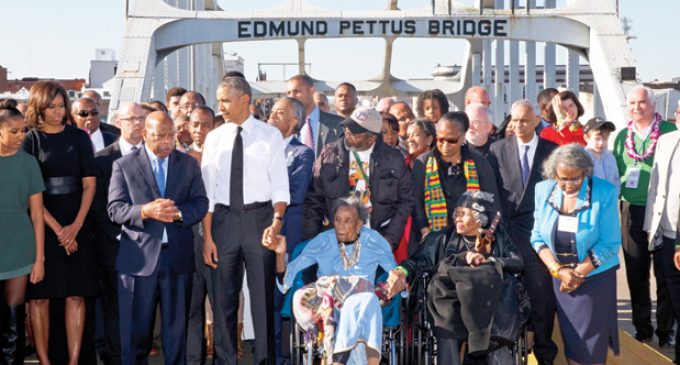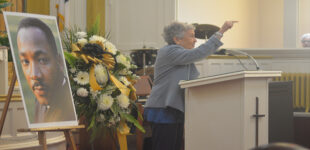Amelia Boynton remembered as the ‘Rosa Parks’ of Selma movement

Above: AP File Photo- Amelia Boynton, in wheelchair next to President Obama, at the 50th anniversary celebration of the Selma to Montgomery March.
By George E. Curry, NNPA Editor-in-Chief
WASHINGTON – Amelia Boynton Robinson, who died Wednesday in Montgomery, Ala. at the age of 104, is being praised as the ‘Rosa Parks’ of the Selma voting rights movement.
Mrs. Boynton, as she was known throughout the movement, had been hospitalized since suffering a stroke in July. She was a courageous voting rights crusader who was brutally beaten on “Bloody Sunday” on the Edmund Pettus Bridge, the first leg of the Selma to Montgomery, Ala. March that provided the impetus for passage of the landmark Voting Rights Act of 1965, which was signed into law by President Lyndon B. Johnson.
She and her late husband, Sam Boynton, opened their home to Atlanta-based voting rights organizers representing the Student Nonviolent Coordinating Committee (SNCC) and the Southern Christian Leadership Conference (SCLC). Dr. Martin Luther King, Jr. also conducted many of his strategy sessions in the Boynton home.
“Dr. Boynton was the straw that stirred the drink. She was a major catalyst in the Selma to the Montgomery march,” said Charles Steele, Jr., president and CEO of SCLC, the organization co-founded by Dr. King. “She helped start and more importantly, bring attention to ‘Bloody Sunday’ and her strength, courage and tenacity helped make Selma the historical icon that we know today. Dr. Boynton was to Selma what Rosa Parks was to Montgomery,” a reference to the African American seamstress whose refusal to give up her seat to a White patron ignited the 1955 Montgomery, Ala. Bus Boycott that propelled King to national fame.
President Barack Obama, who was with the wheelchair-bound Boynton in March to commemorate the 50th anniversary of the Selma to Montgomery March, also praised the civil rights warrior.
“Fifty years ago, she marched in Selma, and the quiet heroism of those marchers helped pave the way for the landmark Voting Rights Act,” he said in a statement. “But for the rest of her life, she kept marching – to make sure the law was upheld, and barriers to the polls torn down. And America is so fortunate she did.”
Obama added, “To honor the legacy of an American hero like Amelia Boynton requires only that we follow her example – that all of us fight to protect everyone’s right to vote.”
Rep. John Lewis (D-Ga.), whose skull was cracked in Selma on “Bloody Sunday,” said: “This nation has lost a crusader, a warrior, and a fighter for justice. She was one of the most dependable, reliable leaders to stand up for the right to vote in Selma, Alabama and in the American South.”
He continued, “Amelia Boynton was fearless in the face of brutal injustice, willing to risk all she had on the frontlines of change in America. She was arrested, shoved and pushed in front of the Dallas County courthouse by sheriff Jim Clark. She was knocked down on Bloody Sunday on March 7, 1965, on the Edmund Pettus Bridge as 600 of us attempted to march to Montgomery to dramatize the dire need for voting rights legislation in this country.”
Lewis noted that Boynton led voter registration drives in Alabama long before he was born.
“She was a co-founder of the Dallas County Voters League in 1933 and held voter registration drives throughout the darkest, most dangerous decades of segregation in Alabama, from the 1930s through the 1950s,” Lewis recounted. “In 1964, she became the first African-American woman to run as a Democratic candidate for Congress in Alabama.”
Born Aug. 18, 1911 in Savannah, Ga., Boynton moved to Selma after graduating in 1927 from what was then Tuskegee Institute in Alabama, now Tuskegee University. She taught in her native Georgia before taking a job in rural Dallas County, Alabama as a demonstration agent for the U.S. Department of Agriculture, helping residents learn about nutrition, health care, food production, and homemaking.
She outlived three husbands. Her first husband, Samuel Boynton, whom she married in 1936, died in 1963, the year before the Civil Rights Act of 1964 was signed into law by President Johnson. Her second husband, Bob Billups, died in 1973. Her third husband, James Robinson, a Tuskegee Institute classmate, died in 1988. She moved to Tuskegee, where she was living at the time of her death, to be with him after they were married.
She is survived by a son, Bruce Carver Boynton. Another son, Bill Boynton, Jr., died last year.
In 1964, a year after the death of her first husband, Boynton ran for Congress, the first female African American to seek that office in Alabama and the first woman of any race to run for Congress as a Democrat. She received 10 percent of the vote, a major accomplishment in an era in which few Blacks were allowed to register.
It was Boynton who persuaded Dr. King to become involved in the Selma movement, which was captured in the popular movie “Selma,” directed by Ava DuVernay. Boynton was portrayed in the movie by Lorraine Toussaint.
King would often hold strategy sessions in the Boynton home.
Boynton was active on the frontlines of the movement.
James E. Fager, author of Selma 1965: The March That Changed The South, recounted a 1965 incident.
“Mrs. Boynton is a tall, aristocratic-looking woman, not inclined to take any guff from James Clark or his trashy policemen,” Fager wrote. “And when she didn’t move fast enough to please the sheriff, his temper flared. He grabbed her by the back of her collar and pushed her stumbling halfway down the block to a sheriff’s car, in full view of the reporter and the astonished black marchers.”It got even uglier when Boynton attempted to march across the Edmund Pettus Bridge in Selma on “Bloody Sunday.”
James Fager wrote, “Mrs. Amelia Platts Boynton, who was standing tall only a few ranks from the front a moment before, had been one of the first to fall, clubbed into unconsciousness. As she fell to the pavement, a creased plastic rainhat that someone had given her slipped down over her face. A trooper came by and dropped a tear gas canister right in front of her, and as the piercing liquid and fumes sprayed out, only the wrinkled sheet of plastic kept it from drenching her eyes and going straight into her lungs.
“Now from between nearby buildings a line of horses emerged at the gallop, their riders wearing the possemen’s irregular uniform and armed with bullwhips, ropes, and lengths of rubber tubing wrapped with barbed wire. They rode into the melee with wild rebel yells, while behind them the cheers of the spectators grew even louder. ‘Get those god-damned niggers’ came Jim Clark’s voice. ‘And get those goddamned white niggers!’”
Two photographs from that day were widely-circulated, one showing her lying on the ground with a White Alabama State Trooper standing over her with a nightstick. The other picture shows a fellow protester trying to lift her up from the ground.
Not only did the marchers complete the 54-mile journey to Montgomery, the Alabama state capital, the United States was forever changed as a result of the Selma movement.
















